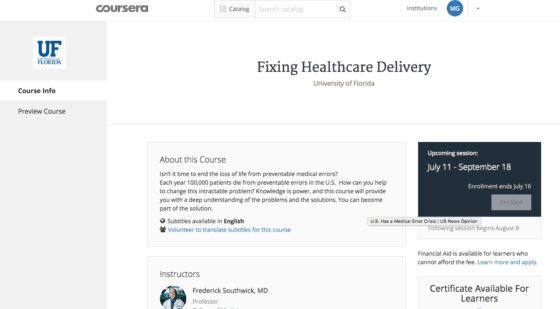 Recently, Chris Jerry, a friend in the patient safety movement (pictured, at left) told me that he was going to be interviewed on a Fox News Channel program about medical errors. You can read or listen (here and here) to my podcasts with him, where he talks about the sad case of his daughter's death, his reaction, and the Emily Jerry Foundation.
Recently, Chris Jerry, a friend in the patient safety movement (pictured, at left) told me that he was going to be interviewed on a Fox News Channel program about medical errors. You can read or listen (here and here) to my podcasts with him, where he talks about the sad case of his daughter's death, his reaction, and the Emily Jerry Foundation.
The Fox News program has a somewhat muckraking title for something that's a very serious topic:
“Beware! Danger at the Doctor”
There are a lot of great things that happen in healthcare, obviously… but there is real danger. The danger is more accurately described as dangers of “the system” not “bad doctors” which is sort of what the title implies.
and I take issue with the title and the first words of the program:
“Warning! Doctors may be hazardous to your health!”, says the voiceover.
That oversimplifies the problem… it's not a problem of “bad apples.” Should they have said “hospitals may be hazardous to your health?”
The program aired Saturday and Sunday. I'm watching it Sunday night via DVR and I'll be blogging and reacting as I get through it (not watching in real time because I'll stop and blog).
Hand hygiene, medication mistakes, medical errors… the death of Joan Rivers (I had wondered from the beginning if that was a medical error)… the program promises to share “what you need to know to protect yourself.” Let's see if there's anything useful.
Will they talk to people like Dr. Don Berwick or others who can describe the “systems thinking” (or lack thereof) aspects of this problem? Chris Jerry understands that these are systems issues and that “naming, blaming, and shaming” won't solve this problem.
Chris Jerry & the Emily Jerry Story
Chris was talked to first in the program. Emily was bouncing back from her second bout with cancer in her 18 months. The doctors recommended one more round of chemo, just to play it safe. She went it for treatment on her second birthday.. she ended up dying as the result of a medication error — a preventable error.
Read my blog post about how the pharmacist was punished and JAILED. Chris doesn't think that was the right response.
Chris investigated Emily's death (why wasn't the hospital??). He suspected the IV and dug through the trash and found the half-full bag… and asked for an administrator in charge. It turns out a “pharmacy technician” made an error and that pharmacist, Eric Cropp, “was busy that day and approved the medication without checking it first.”
My commentary – it seems like it's easy to blame these two people… but what are the systemic factors, including being overburdened and overworked? Why are pharmacy technicians given this responsibility? That surprised Chris.
Chris says he blames himself. He was normally there and this time was unusual in that the IV medication was in a “compounding bag” and he would have asked why. The pharmacy had a stockout on a solution, so the pharmacy tech compounded it. Who at the hospital takes responsibility for the inventory problem?
Another video of Emily's tragic story:
Chris Jerry & Eric Cropp together:
There was a “marginal settlement” from the hospital, because the Jerry family refused to sign a full non-disclosure. I find that appalling.
Chris wanted to keep her story alive and help other children and other patients. I'm glad that he has taken up that fight.
Dr. Marty Makary & Medical Errors
The next segment features the author of the book Unaccountable: What Hospitals Won't Tell You and How Transparency Can Revolutionize Health Care. He's also author of the controversial BMJ study that says medical error is the third leading cause of death in the U.S. Many take issue with the estimates… but we're forced into using estimates when there's so little transparency from healthcare organizations, right?
Just this morning, I read about a hospital in Canada that wanted staff to speak up and point out risks… yet the CEO was uncomfortable with transparency. Ironic, right?
The CEO said:
However, administrators will not disclose the actual number of safety events that occur at the hospital. According to Apkon, going public with error rates could backfire by making various departments look bad. Even if the hospital could provide context for the error rates, public reporting could deter employees from reporting mistakes. “It's a tough balance,” he said.
Who is not being brave… the employees or the CEO? Medical error is not just an American problem, by the way.
It it worse to “be bad” or “look bad?”
OK, back to Fox News…
Dr. Makary described a near miss in the O.R. where the team had prepped the wrong side of a patient's body. “It could have been a disaster, but the question is how many other cases are not caught in time?”
Makary says transparency is part of the solution. It's important to talk openly and honestly within doctors, with nurses, with patients. “Almost every person has a story” about problems in healthcare. One person with a story is a nurse, Jamie Garner… “within 60 days of being a nurse, I saw a patient killed by a medication error.” Garner discovered the medical error (that the patient had been given a large dose of the wrong medication). Another nurse had drawn up the wrong medication. “We killed somebody's dad,” said Garner as she fought back tears.
Makary says the “real number” of patients killed by medical error is “at least 200,000” and probably 250,000.
Bill Hemmer asked, “Do you stand by that number?” Makary says, “Absolutely. Look, these are estimates.” Many of the “causes of death” on death certificates are “guesses,” says a forensic pathologist. Death certificates don't accurately record any medical error, says Dr. Michael Baden. That makes the statistics very difficult to know. There aren't autopsies done to find error.
Dr. Gerard Gianoli says we need more autopsies. The autopsy rate has fallen from 50% to 5%… Dr. Gianoli wants 100% autopsies. Each costs about $1000 and nobody wants to pay for it. He says each pathologist would have to do just one autopsy a week. Dr. Gianoli questions the Makary numbers as “exaggerated” but medical error is a serious problem.
Taking a pause before the next 10-minute segment of the show… I might leave the last 30 minutes of the program for another blog post this week.
Dr. Frederick Southwick
He's listed as a “patient safety advocate” and is author of this book: Critically Ill: A 5-Point Plan to Cure Healthcare Delivery
His wife Mary nearly died as the result of her medical care… starting with a lack of blood thinner that led to other problems… then it was a “miracle” that she walked out of the hospital after being given only a 10% chance of living.
Dr. Southwick took a fellowship at Harvard Business School to study errors in the business world. “The problem with healthcare was that no matter what the quality, you still got paid,” he says.
He's helped lead quality and safety improvement efforts and has an online course through the University of Florida: Fixing Healthcare Delivery. You can take it as a free Coursera course… and I just signed up.
Dr. Southwick was also the victim of a surgical error… during an Achilles surgery, a tourniquet had been placed around his leg for over 2.5 hours (“too long”) and that damaged two of his three arteries below his knee. He ended up with his left leg being amputated.
He said, “No one intended to hurt me.”
That's my point from earlier… if you have good people in a bad system, then that's the primary cause of errors.
Here's an article he wrote in the New York Times about his case.
As I would have suspected, his time at HBS studying errors led him to make the connections with the Toyota Production System, as you can read here:
Production Line Philosophy Can Reduce Medical Errors, Says Southwick
“Before his injury, Southwick had been studying how to prevent medical errors. Then he learned about the Toyota Production System, a management practice focused on producing vehicles as rapidly, safely and efficiently as possible.
[Mark's comment… it's not “as rapidly” as possible, but with the highest quality… safety, quality, and efficiency go hand in hand]
He believed he could apply the philosophy to patient care.
Southwick said that the Toyota Production System is based on three rules: First, every worker must know his or her role within the system. This is called a protocol. Southwick noted that there must be no ambiguity regarding a worker's role. Next, the supply line between two workers must be as simple and direct as possible. Finally, every employee must offer suggestions to increase quality and efficiency.
[Mark's comment — he learned the lessons of Steve Spear]
If these principles are implemented in health care on a large scale, Southwick estimated that costs could be reduced by 30 to 40 percent without impairing quality.
But, what happened with a doctor brought this up to other doctors? We've heard it before:
Southwick tried to apply the Toyota principles to multidisciplinary inpatient work rounds at the University of Florida College of Medicine. He met resistance. Many physicians noted that patients weren't cars.
“So I took Toyota Production System principles and turned them into athletic principles,” Southwick said.
Southwick called it “Gatorounds,” because the University of Florida's mascot is an alligator.
Patients aren't football players, either… but whatever gets through to people.
As he says:
He cautioned that change isn't easy. He recommends that those who wish to adopt changes in health care move slowly and listen to those resistant to change.
“Without change, preventable patient deaths and injuries will continue,” Southwick concluded. “We must change. Our patients are counting on us.”
Yes, we need to do our best to patient and kind to those who are “resistant to change” — working to educate them, meet them where they are, and try to bring them along instead of labeling them as resistant.
Please scroll down (or click) to post a comment. Connect with me on LinkedIn.
Let’s build a culture of continuous improvement and psychological safety—together. If you're a leader aiming for lasting change (not just more projects), I help organizations:
- Engage people at all levels in sustainable improvement
- Shift from fear of mistakes to learning from them
- Apply Lean thinking in practical, people-centered ways
Interested in coaching or a keynote talk? Let’s talk.
Join me for a Lean Healthcare Accelerator Trip to Japan! Learn More












What is the problem? Sensationalism in the media and politic operators that use such for more money, power, and regulation.
Hey, a complicated case has how many discrete actions, people, from beginning to end….like just spitballing here…maybe thousands. The number of errors looked at in that fashion is probably nil percent wise.
Also why no new IOM research from the 2000 study.
Like maybe disaster hospitals cherry picked for there record..…hmm
Hi Mark – Good post. Until hospitals start measuring properly, setting proper improvement goals to close gaps, and then executing accordingly, this problem will not go away. Over the years, we’ve worked with several hospitals to reduce avoidable medication errors and the first KPI we mandate that they set is wanting to see an INCREASE in the number of medical errors being reported.
Naturally, leadership freaks about this and the risk that the media outlets will find out and all that comes from sloppy journalism. However, until they see an increase, you can be sure that errors aren’t being reported and if errors aren’t reported, how can anyone study the system in question and take proper corrective action? It’s a vicious and maddening cycle of an entire industry preferring to wear blinders and in the meantime, people are dying. It all starts with leadership WANTING to see a change, setting the stage environmentally for the change to occur, and then carrying forward. And preferring to see an INCREASE in reported medical errors as a KPI is the place to start.
If media is the enemy for proper resolution, hospitals could opt for engaging with local media outlets upfront, explain the intent and the proper process for problem solving AND HAVE THE MEDIA REPORT ON IT UPFRONT. That could be a Pulitzer-winning approach.
Comments are closed.